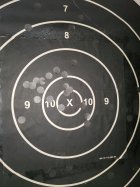Deleted noremaximus
Good morning guys,
I'm always trying to improve my reloading practices. Would you guys mind posting your brass prep for new brass, as well as once fired brass? I'm looking for a method that would yield the best results when it comes to accuracy, and precision. I'll list my brass prep, any critiques would be appreciated.
Lapua Brass
New Brass:
FL size
use mandrel to open up necks (Dry lube)
turn necks
clean in dry media
resize again with FL size to shrink the necks (Should use a neck only die)
run through mandrel once more to set neck tension with a .002 mandrel (Dry lube)
Uniform primer pockets
Deburr flash holes
Clean in dry media
Run a socket with 0000 wool on a drill to clean brass necks
Ready to load
Once Fired Brass:
clean on dry media
Anneal Brass with an Anneleez or what ever its called.
FL size with .002 shoulder bump
set neck tension with .002 mandrel (Dry lube)
clean on dry media
check if brass needs to be trimmed, if so ill trim, deburr, and chamfer brass
brush out necks with nylon bore brush
Run a socket with 0000 wool on a drill to clean brass necks
Ready to shoot.
I'm not saying this is the correct way, but if anyone has any suggestions to improve my brass prep I would really appreciate it. This usually yields me a 4SD, and 25ES with a 20 shot string. Thanks again.
I'm always trying to improve my reloading practices. Would you guys mind posting your brass prep for new brass, as well as once fired brass? I'm looking for a method that would yield the best results when it comes to accuracy, and precision. I'll list my brass prep, any critiques would be appreciated.
Lapua Brass
New Brass:
FL size
use mandrel to open up necks (Dry lube)
turn necks
clean in dry media
resize again with FL size to shrink the necks (Should use a neck only die)
run through mandrel once more to set neck tension with a .002 mandrel (Dry lube)
Uniform primer pockets
Deburr flash holes
Clean in dry media
Run a socket with 0000 wool on a drill to clean brass necks
Ready to load
Once Fired Brass:
clean on dry media
Anneal Brass with an Anneleez or what ever its called.
FL size with .002 shoulder bump
set neck tension with .002 mandrel (Dry lube)
clean on dry media
check if brass needs to be trimmed, if so ill trim, deburr, and chamfer brass
brush out necks with nylon bore brush
Run a socket with 0000 wool on a drill to clean brass necks
Ready to shoot.
I'm not saying this is the correct way, but if anyone has any suggestions to improve my brass prep I would really appreciate it. This usually yields me a 4SD, and 25ES with a 20 shot string. Thanks again.
Last edited by a moderator:











